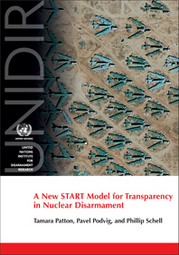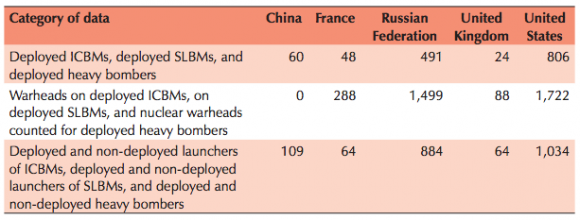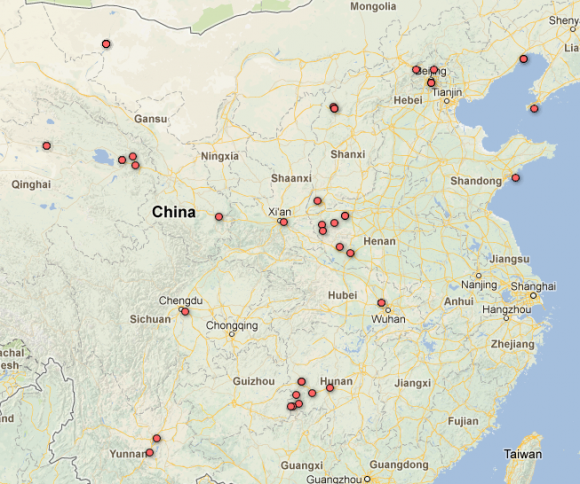 Last week, I was lucky to be able to join NPT PrepCom-ers in Geneva to help present the recently completed UNIDIR study ‘A New START Model for Transparency in Nuclear Disarmament,’ carried out by Pavel Podvig, Phillip Schell, and myself.
Last week, I was lucky to be able to join NPT PrepCom-ers in Geneva to help present the recently completed UNIDIR study ‘A New START Model for Transparency in Nuclear Disarmament,’ carried out by Pavel Podvig, Phillip Schell, and myself.
The work is accessible on the recently launched nuclearforces.org website, where you can check out the overview report, the individual country reports, some nifty maps, or download the KMZ set.
As the P5 continue to seek ways to show up on their 2010 Action Plan commitments (especially those repeatedly mentioned by name that are related to disarmament, transparency, and reporting – Action 5, 20, & 21), the aim of this project was to demonstrate the feasibility and practicality of applying New START definitions and provisions more widely to the other NPT nuclear weapon states. Yes, New START was specifically designed for the arsenals of Russia and the United States, so why would we do such a thing? The overview report says it best:
Even though the New START transparency and accountability provisions were developed in the context of bilateral US–Russian nuclear arms control, they could be applied to the nuclear arsenals of other nuclear-weapon states. The key advantage of New START is that it provides a legal and organizational framework for nuclear reductions that has been thoroughly tested in practice. Extending this framework to all nuclear-weapon states would be a natural and direct way of building a comprehensive system that could ensure transparency and accountability in nuclear disarmament.
Over decades of trial and error, Russia and the United States have learned many a lesson in terms of what works and what doesn’t when it comes to effective mechanisms for transparency, notifications, inspections, and general verification in arms control. Therefore, in thinking about a transparency system for pursuing multilateral disarmament in line with the 2010 Action Plan, we think it makes good sense to build upon this experience rather than to start from scratch.
In this project, using a variety of open sources and geospatial tools, we generated New START-type MOUs for each of the P5 states, which include the relevant aggregate numbers, facilities, geographic coordinates, and weapon system technical data.
Here are the New START-type aggregate totals for each state as of 1 September 2012:

(Data for the United States and the Russian Federation come from the biannual exchange required by New START, which contained data declared current as of 1 September 2012. Data for China, France, and the United Kingdom are estimates based on open-source information.)
The numbers might look a little strange at first, but this is what you get when you apply a consistent methodology (something that the open source community tends to be rather lax about) as defined in New START. The treaty clearly defines an ICBM, SLBM, or heavy bomber based on range, it presents good definitions for determining deployment status, and the limits of the treaty provide a useful measure for determining which forces should be considered “strategic” if only for the purposes of consistent reporting across the P5. The detailed story behind each of these numbers can be found in the country reports, but here are a few key points:
- The only systems included in the aggregate numbers are those with ranges that meet requirements specified in New START (ICBMS, > 5500km; SLBMs, > 600km; Heavy Bombers, > 8000km or with nuclear long range (>600km) ALCMs)
- This data reflects the status of arsenals on the date of 1 September 2012, and therefore the numbers might look quite different on another date. For instance, part of the reason the UK’s numbers are relatively low is because two submarines (as opposed to the usual one) were considered to be in overhaul on this date.
- The reason for the glaring zero in China’s deployed warheads category is due to the general belief that no warheads are actually mounted on China’s ballistic missiles.
The aggregate numbers in the table above do not present a complete picture of each state’s nuclear arsenal, but it’s a good starting point in terms of reporting. More importantly, the framework and system that New START provides could of course be built upon over time to incorporate new weapon systems (i.e. Russian and U.S. non-strategic forces, French nuclear aircraft, and Chinese missiles with lower ranges) in a sustained and consistent manner.
In completing the MOUs for each state, it was also interesting how much of the necessary data was already available in the public domain. Despite the fact that the United States removes the coordinates from its New START data releases and that Russia refuses to allow the disclosure of anything beyond its aggregate numbers, the MOUs for both of these states (including geographic coordinates for all facilities) could be rather easily assembled using open sources and Google Earth. The same goes for the much shorter MOUs generated for France and the UK, which would each have very few facilities to report. For China, the process required more effort, but thanks to the growing body of research and the increasing availability of commercial satellite imagery, we were able to identify many of the relevant facilities with reasonable confidence.
As an example, the map below shows nuclear forces bases and other facilities that would be included in China’s New START-type data exchange report. Click on the image to go to the larger interactive version (tip: click on the ‘satellite’ option to be able to view the actual sites when zooming in):
With each succeeding Russian-U.S. arms control agreement, the definitions, mechanisms, and procedures have been adjusted to account for lessons learned. New START stands as the most recent iteration of this process, and while it may not be perfect, it represents a history of cooperation and negotiated agreement between the two states with the largest nuclear arsenals. Moreover, it contains many elements that could serve as a useful basis for elaborating a multilateral transparency and disarmament system.
As starting points go, we think that’s pretty good.
(For a more eloquent description of the project, also check out Pavel’s recent post.)


There seems to me a discrepancy between the general concept of transparency and “data … already available in the public domain” on the one hand, and the claim that
“The reason for the glaring zero in China’s deployed warheads category is due to the general belief that no warheads are actually mounted on China’s ballistic missiles”.
Transparency comes from data, not belief. China’s actual deployment of nuclear weapons is one of the least transparent matters in arms control this side of North Korea, and I think we may be getting distracted by the fact that we can fairly easily count and analyze China’s missiles and bombers. Since we can’t see the payloads, we just accept what “everybody knows”, and go back to looking at the imagery because that is all we can do. But it is the payloads that are the important part.
And this isn’t limited to China. There’s a disturbingly large segment of the Pentagon that likes the idea of widely deployed hypersonic cruise missiles on the grounds that they can strike any target, any time, without warning or defense, yet are totally non-destabilizing on account of “everybody knows” they aren’t nuclear.
Were I a Chinese or Russian policymaker, I might have a different thought regarding an arsenal of hundreds or thousands of stealthy, unstoppable missiles that are – hey, trust us on this – guaranteed Not Nuclear, operated by the same nation that keeps bunkers filled with hundreds or thousands of lightweight thermonuclear warheads that are – trust us on this one as well – totally not being attached to missiles.
Regardless of which country’s missiles we are looking at, I think it is more accurate and informative to count nuclear-capable delivery systems than to try and guess at actual deployed nuclear weapons.
The point here is that it would be good if China officially declared that it has zero deployed warheads. As for counting “nuclear capable delivery systems,” there are two rows in the table for that – deployed systems and the total number of launchers.
Finally, “hypersonic cruise missiles” are nowhere near being “widely deployed,” but if it comes to that, New START has a mechanism for counting them – they could be included in the “strategic launchers” category.
My point is that the “deployed warheads” column is worse than useless without A: credibly verifiable numbers and B: an explicit and relevant standard as to what counts as “deployed”. I’d also like a count of the non-deployed warheads and an explanation of what they are for, but that is not essential.
Whether or not a warhead is physically attached to a missile, a missile loaded into a launcher, right this instant, is not relevant. If we make that the standard for a new arms control treaty, all we accomplish is to encourage gamesmanship and the development of speedloaders for nuclear weapons. Which IMO would actually be slightly destabilizing.
If China wants to move towards actual transparency w/re its nuclear arsenal, that would be good. If all China does is say that it has zero “deployed” warheads, I don’t see how that does any good at all.
“If China wants to move towards actual transparency w/re its nuclear arsenal, that would be good. If all China does is say that it has zero deployed warheads, I don’t see how that does any good at all.”
If we’re talking about China moving toward greater transparency, it is of course unrealistic to ever expect them to reveal everything we want to know at once. Although it would not in itself be verifiable, declaring zero warheads on deployed systems would be a small but valuable first step that would tell us a great deal beyond what we think we know now in terms of readiness and (when combined with the other two New START aggregate data categories) numbers of systems above the ranges specified in the treaty. Of course the process shouldn’t stop here, but it needs to start somewhere.
Also, I think it matters that there is no ‘deployed warheads’ category in New START (and it’s my mistake for calling it as such in the post). The category is ‘warheads on deployed delivery vehicles’, and the treaty does of course have explicit standards as to what counts as a deployed DV and launcher. It’s a clean, practiced way of counting warheads that when applied to the rest of the P5 would allow for the eventual incorporation of various categories of warheads not located on delivery vehicles in a consistent manner further down the road. Again, the point is that these aggregate declarations would be a first step in a bigger process and not a once-and-for-all transparency standard in arms control.
As it happens, New START provides both A and B.
As for the fear of “gamesmanship,” the numbers of deployed delivery vehicles and the total number of launchers give you the upper limit what a country could deploy – you are free to assume that China has enough warheads to put on all its 109 launchers. If you want, assume that they are all MIRVed.
John, I assume you don’t mean to argue that China should mount nuclear warheads on its ICBMs for the sake of transparency.
Let’s not blame the Chinese for the way New START is written. It wasn’t created with them in mind. Some adaptation of the New START transparency rules might be required for the P-5 context.
For example, if the Chinese were ever to adopt New START transparency measures, another twist would be that New START doesn’t distinguish between nuclear and non-nuclear warheads on ICBMs and SLBMs. That wrinkle allows the U.S. and Russia the freedom to mix their missile payloads under the agreed ceiling. But if China were to field conventionally armed ICBMs while keeping nuclear warheads de-mated, or if other participants were to adopt a similar posture, it would lead to the odd effect of only counting conventional warheads.
What sort of adjustments might be called for will depend on whatever transpires between today and whenever China, France, and the UK develop a real interest in participating.
Nice idea. Neat project. Sweet cover design. Looks hauntingly familiar…